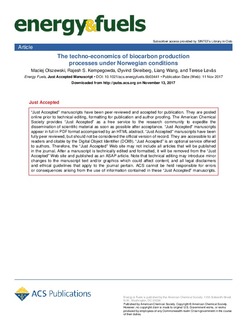| dc.description.abstract | This work deals with techno-economic analysis studies in the context of production of various grade biocarbon for utilization as reducing agents in metallurgical industries. A detailed process design was developed for wood handling, debarking, chipping, drying, carbonization, and combined heat and power production using Aspen Plus for 10 ton per day (TPD) biocarbon output. A Fortran based user defined function was developed for the carbonization process by considering pressure, temperature and particle size effects using a Box–Behnken approach. The empirical correlation indicates a strong influence of temperature as well as a significant influence of pressure and particle size on the biocarbon yield and its fixed carbon content. Fixed carbon content increases with temperature, pressure, and particle size. Mass and energy balance results from Aspen Plus provided necessary results for cost parametrization considering three influencing parameters: temperature, pressure, and plant scale on the equipment costs; operating expenses; and production cost of biocarbon. Four scenarios are compared, i.e., logwood supply, woodchips supply, coproduction of biooil, and replacing the carbonization agent from nitrogen to air. The results indicate that logwood supply is more economical than supplying woodchips to the plant gate. Economic benefits in terms of cost are ∼5% (at 1 bar and 450–500 °C, 55–60 TPD) and ∼4% (at 10 bar, 450–500 °C, 55–60 TPD). Coproduction of biooil decreased the production cost of biocarbon ($/GJ) by 40–44% (at 1 bar, 450–500 °C, 40–60 TPD) and 30–36% (at 10 bar, 450–500 °C, 40–60 TPD), respectively. Finally, the economic return based on IRR suggests that the highest IRR is achieved for scenario C, where biooil is a coproduct; it is due to high market price of woody tar at 500 $/ton. Transportation of forest biomass (logwood) from 20 to 220 km increased the cost of logwood from 4.75 to 7.15 $/GJ, which is significant in terms of operating cost. | nb_NO |
